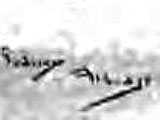

|
 | Sidney Aldridge(c.1875-?) |  |
||
|
I have been unable to fing any online biography of Sidney Aldridge. The 1901 census has a Sidney Aldridge lodging in Lincoln Street, Chelsea, whose occupation is given as "Artist, Black & White" and I think this must be him. His age is given as 26 and his birthplace as Chelsea, but there are no Sidney Aldridges registered there between 1874-6. He may have been registered under his mother's name, or have adopted the surname of a stepfather. He seems to be absent from the 1911 census, presumably abroad, perhaps on the Continent , perhaps visiting America. I have not been able to trace him via the electoral rolls, or any death or marriage registration. That he was an illustrator is evidenced by his work appearing in The English Illustrated Magazine in 1907, illustrating Percy Sandown's ghost story The Last Skipper of the "Lapwing" [see link below]. In 1914, on the outbreak of the First World War, Aldridge made a 'Lightning Artist' short, War Cartoons (released September 1914) for Warner's Features (the London branch of the US distributor), who promoted him as "a famous contributor to Punch", a somewhat exaggerated claim. It is not evident whether this film contained any animation, but his second film, War Skits released 17 December by New Agency Film Company, was described in The Bioscope (12 November 1914) as: An unusually clever series of humorous trick drawings as befitting the times, of a popular nature. The ingenious contributor to Punch hits off the new Napoleon, otherwise 'Bill,' in fine style, and ends the film with a fine drawing of 'K of K' (i.e. Kitchener of Khartoum)." The word 'trick' would imply animation, and his next film venture would suggest an enthusiasm for animated story telling. In the 21 January 1915 issue The Biograph entry for The Adventures of Willie Woodbine and Lightning Larry (New Agency 1915) read: The first of a series by Sidney Aldridge by a combination of trick scenic effects and knockabout business. This first episode of the adventures of a pair of down-and-outs was entitled A Joy-Ride to the Cannibal Islands. With the aid of a magnet and a magic wand the duo take to the air in a balloon, according to the description quoted by Gifford, the magnet attracting all the houses from the village of Slopton-on-Mud as they pass over it. Drifting across the North Sea they drop bombs on the Kiel Canal, to the confusion of British Admiral Jellicoe, before arriving at the 'Cannibal Islands'. Here they are given permission to settle by King Howdedo, and "after an adventure with two dusky flappers" they plant the model village of Slopton-on-Mud. It would seem there is no existing print of this film. Tramps had been popular anti-heroes in the British comics since Tom Browne created Weary Waddles and Tired Timmy (later Weary Willie and Tired Tim) for Illustrated Chips in 1896, and Aldridge's characters would seem to come from this tradition. WD & HO Will's "Wild Woodbines" were a popular 'gasper' (harsh, unfiltered cigarette) available in packs of five, and the subject of a popular song Little Willie's Wild Woodbines (about a precocious 6-year-old's attempt at smoking) written in 1908 and recorded on cylinder by the music Hall performer Billy Williams in 1913. ("Woodbine Willie" was also the nickname given to the Reverend Geoffrey Studdert Kennedy, an army chaplain from the beginning of 1915, for his practice of handing out cigarettes to the troops, a critical examination of which forms the first poem in his anthology The Unutterable Beauty, published in 1921. The nickname was a common one, and probably derived from the song.) "Lightning" was slang for gin in the UK, so it may not have been speed that Larry's nickname referred to. In his thesis Animating perception: British cartoons from music hall to cinema, 1880 - 1928 Malcolm Cook reports that The Adventures of Willy Woodbine and Lightning Larry was criticized as being "marred by indifferent quality". It is possible that this review, taken with a resulting lack of interest from exhibitors, resulted in the immediate termination of the series, but one might have expected a least one more episode. Another possibility is that Aldridge, at the age of 39, might have volunteered for military service in response to Kitchener's "Your Country Needs You" campaign, although again this seems unlikely as it could have been argued that filmmaking contributed to the war effort by raising morale. Conscription did not come in until 1916. But whatever the reason A Joy-Ride to the Cannibal Islands was the only episode made, and Aldridge appears to have nade no further films. |
Filmography | ||||
| War Cartoons by Sidney Aldridge | (Warner's Features, September 1914) On-screen Artist, Animator(?) | |||
| War Skits by Sidney Aldridge | (New Agency, December 1914) On-screen Artist, Animator | |||
| The Adventures of Woodbine Willie and Lightning Larry: A Joy-Ride to the Cannibal Islands | (New Agency, January 1915) Designer, Animator | |||
Links to Other Sites | ||||
Internet Archive - The English Illustrated Magazine 1907: short story "The Last Skipper of the 'Lapwing'" with 5 illustrations by Sidney Aldridge. |
Peter Hale
Last updated 2017
|